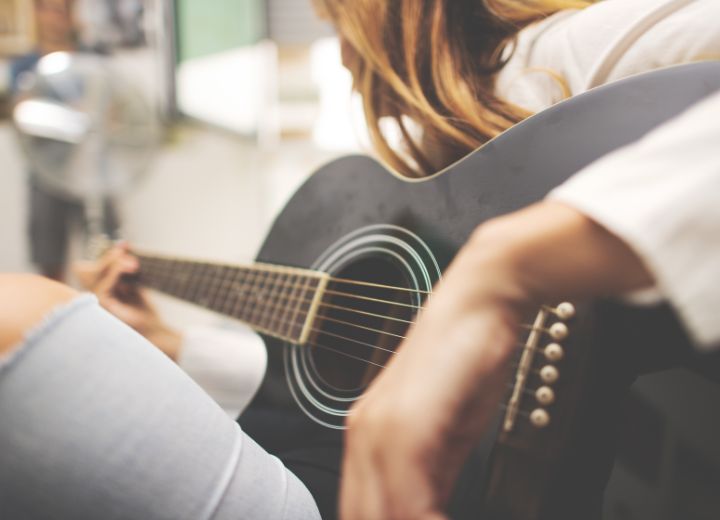Playing the guitar is a beautiful experience. But it can also be physically tiring, especially for left-handed guitarists.
When your left hand guitar position is correct, you’ll notice improved accuracy, speed, and control. It also helps prevent strain and potential injuries.
Proper Finger Placement for Left-Handed Players
Focusing on your finger placement would be best to achieve a correct left-hand position.
First, position your thumb on the back of the guitar neck. Then, slightly point towards the headstock. This allows for better control.
Next, avoid gripping the neck too tightly, as it can restrict your finger movements and cause unnecessary tension.
Then, ensure that your left-hand fingers are arched and curved. This hovers just above the strings. Your fingertips should press down on the strings firmly but without pressure, reducing the risk of muting or buzzing strings.
When transitioning between chords or notes, focus on lifting and placing your fingers individually rather than keeping them constantly pressed against the strings.
Lastly, experiment with different hand and finger positions to find what feels most comfortable and natural for you.
How to Improve Left-Hand Position
Improving your left-hand technique is essential for comfortable and effortless playing. Here are some tips to help you avoid strain:
Practice proper posture
When you play classical guitar, keep your posture straight and comfortable. With your shoulders relaxed and your back upright, either sit or stand.
Avoid slouching or hunching over the instrument. This can lead to discomfort.
Take regular breaks
Playing the guitar for extended periods can strain your hand muscles. Take short breaks every 20-30 minutes to stretch your left hand finger. This will prevent fatigue and reduce the risk of repetitive strain injuries.
Warm up before playing.
Like any physical exercise, warming up your hands and fingers before playing can benefit your left-hand technique.
Perform simple exercises, such as finger stretches and hand rotations, to loosen your muscles and increase flexibility.
Avoid excessive force
Applying excessive force to press down on the strings is unnecessary. But it can also cause discomfort.
Find the right balance between firmly fretting the strings to produce clear notes. This is to avoid unnecessary tension.
Use lighter gauge strings.
Experimenting with lighter gauge strings can make a noticeable difference in reducing the effort required.
Lighter strings are generally easier to fret. This allows for a more comfortable playing.
You’ll gradually improve your left-hand technique and minimize the risk of strain or injury.
Left-Hand Guitar Position for Different Playing Styles
Here are two common playing styles:
Strumming
When strumming, it’s important to maintain a relaxed hand position. Position your hand slightly above the soundhole, with your fingers loosely curled.
Use your left wrist to generate the strumming motion. This allows for a fluid and natural movement. The strumming position provides optimal control and allows for efficiency across the strings.
Fingerpicking
This requires a more precise and controlled left-hand position.
Rest your left thumb on the back of the guitar. Use your index, middle, and ring fingers to pluck the strings.
Keep your fingers arched and close to the strings for accurate and clean fingerpicking. Aim for a relaxed and balanced hand position to avoid unnecessary tension.
Different Genres of Music for Left-Hand Guitar
The left-hand guitar position can also vary depending on the genre of music you play. Here are some guidelines for left-hand guitar position in popular genres:
Rock and Blues. Power chords and fast riffs are common in rock and blues music. Place your left thumb behind the guitar neck and use your index and ring fingers to fret power chords to achieve a comfortable left-hand position. This grip allows for better control and facilitates speedy transitions between chords.
Jazz. Jazz guitar requires a more intricate and good left-hand technique. Position your thumb in the middle of the back of the guitar neck, and use your fingers to fret complex chord voicings. Maintain a relaxed hand position to facilitate smooth and fluid jazz playing.
Classical. Classical guitarists often adopt a more traditional left hand. Place your thumb behind the guitar neck, slightly protruding towards the headstock. Use your fingers to execute intricate fingerstyle patterns and arpeggios. This position allows for greater precision and control over the strings.
It’s important to note that these are general guidelines, and personal preferences may vary. Experiment with different left-hand positions to find what works best for you in various genres of music.
Final Thoughts
Finding an excellent left-hand position is essential for comfortable playing and improved technique. Remember to be consistent in your practice.
The guitar wasn’t built in a day, and neither will your guitar skills. With dedication and perseverance, you’ll soon find yourself playing your favorite tunes with ease, confidence, and comfort.
So, keep practicing, exploring, and enjoying the beautiful journey of playing guitar.

